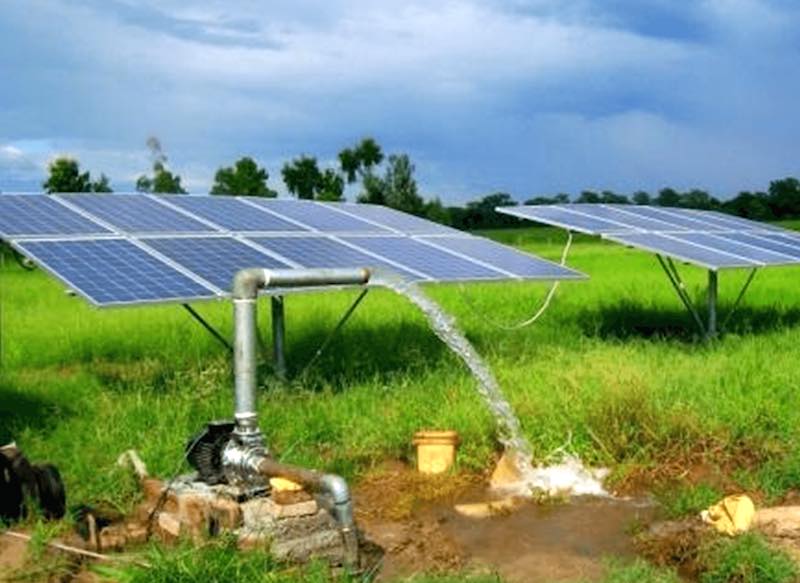Solar Water Pumps: Things To Know and Tips For Use
- Introducing solar-powered irrigation for poor and remote areas
- What is a solar water pump and what are the most popular types?
- Why solar-powered water pumps are the ideal way to boost agriculture in remote areas (And Africa)
- Are solar water pumps worth the investment?
- How to buy an efficient solar water pump?
- The conclusion
Mechanical pumps have a lot of uses nowadays. They are common in pumping water from wells, aquarium filtering, pond filtering and aeration. When it comes to water pumps, the main use of this device is the exchange of fluids such as water.
From agriculture to the energy industry, pumps are found in a wide range of applications. The main working principle of a water pump basically depends upon the positive displacement principle and kinetic energy which helps pushing the water.

Solar water pumps are a relatively new concept in mechanics. A solar water pump system is commonly seen in residential and commercial uses, as well as for irrigation of agricultural land. Through solar panels, the pump can eliminate the cost of energy and provide a more feasible option that uses energy from the sun (and not fuel-burning mechanisms) for pumping water.
Introducing solar-powered irrigation for poor and remote areas
In times when the entire world is switching to solar, using the sun’s energy in water pumping systems can significantly help and accelerate the development of agriculture in African countries and many other poor remote areas. This concept is known as solar-powered irrigation and is used in many regions nowadays.

The truth is, solar energy might be the easiest way for farmers to produce energy, especially for those living off the electricity grids with poor infrastructure around their homes. Therefore, the use of solar water pumps in agriculture is becoming increasingly popular. The concept of solar irrigation represents a virtuous circle—when the sun shines, it feeds the irrigation system and feeds the crops which are dependant on water in sunny weather. Therefore, a large quantity of energy is being released right at the time when it is needed the most.
Solar irrigation is a concept that works through solar water pumps. Below, we are describing them in detail.
What is a solar water pump and what are the most popular types?
As we discussed before, solar pumps present a clean, simple and energy-efficient alternative to traditional electric and fuel-driven pump sets. They are part of an environmentally friendly approach in agriculture and can be used to exploit every region, whether its developed or poor.
Due to their immense potential for productive use and agricultural productivity, solar water pumps are now powering more and more agriculture projects. Knowing that 40% of the global population relies on agriculture as its main source of income, access to water remains an ongoing struggle for many people. This is what solar aims to change and introduce a cost-effective future for around 500 million small-scale farmers all around the world.
The main components in a solar pumping system include a photovoltaic (PV) array, an electric motor and a pump. Solar water pumping systems, on the other hand, are classified as either direct current (DC) or alternating current (AC) systems based on their motor’s ability. Recently, the concept of brushless DC (BLDC) motors for solar pumping water applications was presented as well.
Classification and types of solar pumps
When it comes to stand-alone solar pumping systems, the main types include rotating and positive displacement pumps. Centrifugal pumps are the common choice for rotation and are designed for fixed head applications. Their output increases in proportion to their speed of rotation.
Additionally, pumps are also classified as submersible and surface pumps, based on their placement (underwater and above the waterline).

Source: [Report] Solar Water Pump Technology Roadmap
All in all, the main aspect related to the efficiency of a solar water pump is based on three variables including pressure, flow and input power to the pump. Wire-to-water efficiency is the commonly used metric that determines the overall efficiency of a solar water pump (as the ratio between the hydraulic energy that comes out of the pipe and the energy coming over the electrical wires through solar panels).
Why solar-powered water pumps are the ideal way to boost agriculture in remote areas (And Africa)
A solar-powered water pump is a concept that is environmentally-friendly. More importantly, it is a concept that gets rid of any power grids or fossil fuels used to pump water out of the ground. Below, we are listing the advantages and disadvantages of their use.
Advantages of solar water pumps
The first advantage of solar pumps is that they are reliable in regional and remote areas. A perfect example of this is Africa, which is one of the poorest remote regions in the world with an abundance of water—but also the most dominant region when it comes to most days of sun in the year. On the flip side, Africa is thought to possess 9% of the world’s freshwater resources which translates to around 4,000 km3 of water per year. Deploying solar water pumps in Africa is, therefore, the perfect alternative to any other fuel-based sources—and an alternative which can stimulate life in every part of this continent.

Easy to transport and relocate, solar water pumps can be organized as per the needs of the farm and have extremely low operating costs. Both of these are major advantages, paired with their cost-efficiency in the long run, show that a solar water pumping system is the perfect solution for regions with sunny days and plenty of water on their grounds.
Major disadvantages
The main disadvantage of deploying a solar-powered irrigation pump for agriculture is its cost (initial investment). Even though it depends on the power of the specific pump, one 120 Watt solar pump which promises to produce 2,100 gallons of water per day can be found on online marketplaces from around US$235. An entire system for a solar-powered irrigation pump based on one pump can also be found for around $498. Other sites like eBay, the prices for kits like these are relatively the same.
Obviously, there is a major difference between deploying a solar water pump for your home and one for an agriculture project. With different types, sizes and needs come different costs. There are cheaper and more expensive models but the average cost of solar water pumps is generally high, considering the fact that many of them need to be deployed for effective irrigation. All in all, compared to the cost of fossil fuels and other types of energy, solar is still a winner in the long run.
In addition to this, solar energy in agriculture is also very weather-dependent. Even though solar energy can still be collected during cloudy and rainy days, the efficiency of a solar system drops. This is why solar irrigation systems are best used in regions with a lot of sunlight.
Are solar water pumps worth the investment?
One important thing to note when it comes to solar pumps and irrigation systems is the fact that their costs have dropped significantly in the past few years. According to new research from the International Renewable Energy Agency (IRENA), there will be a 59% cost reduction for electricity generated by solar PV by 2025 compared to the 2015 prices.
As such, the economic viability of these systems varies for different regions and areas, mostly depending on site conditions, crops and markets. An infographic from The World Bank shows that in 1997, the average price of deploying solar energy per watt was $76. In 2015, that price was $0.3 which clearly showcases the drop in prices. Now, a solar panel has an average lifespan of 25 years and compared to diesel pumping, it lacks any fuel and presents less operation and maintenance. The only disadvantage is its initial cost which is around two times higher compared to diesel water pumping systems.
Price is also a key differentiator when it comes to returns on investment (ROI). The key aspect that determines the economic viability (the factor associated with the worth of solar water pumps as an investment) is how the solar-powered systems compared with other forms of energy.

Source: Solar Water Pump Technology Roadmap
Generally speaking, diesel pumps have low initial investment costs but are also associated with high operation and maintenance costs, not to mention their negative impact on the environment and ecology. In contrast to this, a solar water pumping system has higher investment costs but lower maintenance and operational costs.
So, the key takeaway of the “is it worth it” question is the following…
If you are based in a region with plenty of sun and a lot of groundwater, a solar water pumping system is definitely recommended. Despite the initial installation costs, lower maintenance costs and a higher lifespan will give you an up-and-running system set in no time, clean water and many benefits in the long run.
How to buy an efficient solar water pump?
As we mentioned above, the investment costs associated with buying solar water pumps are coming down in the past few years. However, the factors which influence the efficiency of a solar water pump are numerous and include:
- Economic viability
- Access to money
- Installation, operation and maintenance
- Standardization and quality control of products and service
- Water management
- Social justice
Considering these factors, we can say that solar water pumping can provide significant environmental and socio-economic benefits at the farm and national levels. At the farm level, the technology can present a reliable source of energy in remote areas—and especially areas that are not connected to the electricity grid or lacking a regular supply of liquid fuels. On a national level, solar water pumping can help stabilize, increase and diversify agricultural production, which is the foundation of most African countries’ economies.
By definition, an efficient solar-powered water pumping system is one that receives plenty of sunlight and is installed specifically to the needs of the farm.
In a world where there is a current energy crisis, there is a strong drive towards renewable energy. Despite the costs which are relatively higher, the real efficiency of solar systems is seen in their use over the years. As a renewable energy option, the exploitation of solar energy is a valuable option.
The focus of deploying solar water pumping is obviously set to South Africa and regions with poor economic development but plenty of sunlight. Paired with the right environmental conditions, the right amount of PV panels and controllers and the right installation setup of energy storages, converters, inverters, pumps and motors—the solar water pumping system can present a farm and a nation with numerous benefits.
The conclusion
If you are thinking or considering the applications of solar energy for agriculture, the benefits are numerous. With the ability to pump water for irrigation during dry and sunny weather in regions that need it most, panels like these can be easily installed and enable the pumps to work in wells of very low yields, offering a longer lifespan and plenty of energy in the long run.

